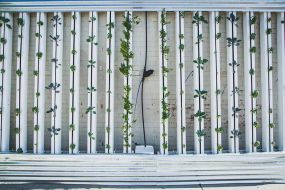Five Reasons You Should Have a Vertical Garden

Many people are choosing to grow their own produce at home. Whether it is because of food costs, access to fresh vegetables, or just as a fun hobby, indoor gardening is becoming more popular every day. Some further benefits to indoor vertical gardens include:
1) Maximized Space
Living in an apartment or small home leaves little room for a traditional garden. The large amounts of soil and space required for planting a variety of greens is virtually impossible to fit onto an apartment balcony or small backyard.
Fortunately, a vertical garden can solve all these problems. Made for indoor use, vertical gardens have been crafted to maximize a small amount of space. The many tiered levels reduce the amount of floor space needed; the structure expands upward rather than outward.
Through hydroponic systems, vertical gardens can also eliminate the need for soil. This allows more plants to be added, reducing the overall amount of space needed.
2) Simple Organization
Because the hydroponic system relies on each plant receiving the proper amounts of water and light, the possible locations for plants are preplanned by the manufacturer. This makes organization very simple.
Not every plant requires the same amounts of light, but many have similar light cycles. Vertical gardens are often arranged in easily accessible rows or sections by light. This makes it easy to group plants that require different types and amounts of light together.
The simplicity of rows also makes it easy to see which plants grow faster, allowing the gardener to place those that require regular harvesting to be placed in the most accessible locations. This makes gardening with a vertical garden enjoyable and stress free, as everyone is able to organize their plants exactly how they want.
3) Easy Maintenance
In a traditional garden, there are many maintenance tasks that must be carried out regularly, sometimes every day, to ensure the health of the growing plants. These include watering, weeding and shading. In a vertical garden, the hydroponic system takes care of all these tasks.
In a hydroponic system, nutrient rich water is pumped around the roots of every plant, allowing easy access to all the nutrients the plants need to grow and thrive. Because of the enclosed nature of vertical gardens, along with the lack of extra space, weeds are a rare occurrence.
The hydroponic system also allows the light cycle to be adjusted independently for different levels and bulbs in the vertical garden. This allows each plant to get the right amount of light with no extra fuss.
The only maintenance task required, aside from harvesting and planting greens and herbs, is keeping the water reservoir filled. Hydroponic systems rely on water to feed each plant nutrients, so these levels must be maintained. Vertical gardens come with a water reservoir and dissolvable nutrient packets for each refill.
4) Optimal Growing Environment
Traditionally, plants use large, branched root systems to absorb water and nutrients from the soil. Growing and energizing these systems uses a large amount of the plants’ available energy and often does not result in maximum absorption. This inefficiency in nutrient collection makes it more difficult for plants to grow to their full potential.
A vertical garden eliminates this issue. In hydroponic systems, the water pumped through the garden is full of all the nutrients the plants need. With the nutrients brought to them, all the plants need to do is absorb them. Because they are not required to spend energy enhancing their root system to find nutrients, plants in a vertical garden are able to grow and mature two to three times faster.
5) A Diverse Vertical Garden
Due to the variety of light settings and constant nutrient fuel, many different types of plants can be grown in a vertical garden. A variety of fruits and vegetables, such as cucumbers, tomatoes, beans and strawberries, are quite popular for vertical gardens. With larger plants, it’s important to consider the size of the vertical garden before planting seeds. If a plant grows too tall for the vertical garden, it should not be planted.
Edible greens such as lettuce, kale or spinach are also popular, along with herbs such as basil or dill. These plants are typically smaller and thrive in hydroponic vertical gardens. Once they reach maturity, these plants can provide fresh flavors all year.
Vertical gardens are a great way to grow fresh produce, whether there is space for a traditional garden or not. They allow plants to thrive and mature quickly, requiring a very small amount of maintenance. With a vertical garden and a little bit of care, any kitchen can be supplied with fresh produce and greens.







